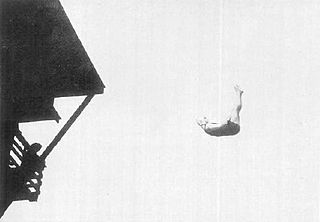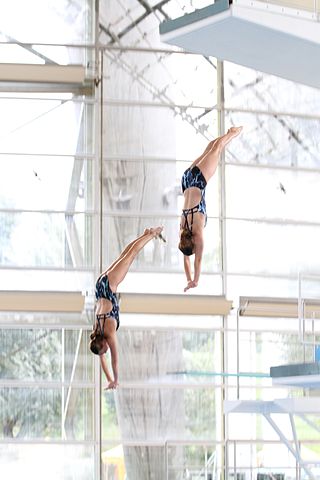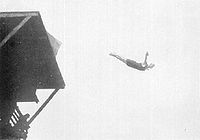
Diving is the sport of jumping or falling into water from a platform or springboard, usually while performing acrobatics. Diving is an internationally recognised sport that is part of the Olympic Games. In addition, unstructured and non-competitive diving is a recreational pastime.
The men's 10 metre platform, also known as the high diving competition, was one of two diving events on the diving at the 1908 Summer Olympics programme, along with the men's 3 metre springboard. The competition was held from Monday 20 to Friday 24 July 1908. Twenty-four divers from six nations competed. Each nation could enter up to 12 divers.
The men's 3 metre springboard, also known as the fancy diving competition, was one of two diving events on the Diving at the 1908 Summer Olympics programme, along with the men's 10 metre platform. The competition was held on Tuesday 14 and Saturday 18 July 1908. Twenty-three divers from eight nations competed. Each nation could enter up to 12 divers.

The United States competed at the 1912 Summer Olympics in Stockholm, Sweden. 174 competitors, took part in 68 events in 11 sports. Out of the 174 athletes who had participated, 64 won medals.

The Russian Empire (Russia) competed at the 1912 Summer Olympics in Stockholm, Sweden. 159 competitors took part in 62 events in 15 sports.

Norway competed at the 1912 Summer Olympics in Stockholm, Sweden. 190 competitors, 188 men and 2 women, took part in 58 events in 14 sports.

Finland competed at the 1912 Summer Olympics in Stockholm, Sweden. The Grand Duchy of Finland was an autonomous part of the Russian Empire at the time, which allowed Finland to compete separately of Russia Russia at the 1908 Summer Olympics due to Finland's special status. During the opening ceremony, Finland's team paraded under the national insignia flag of a Swedish-speaking female gymnastics club in Helsinki. 164 competitors, 162 men and 2 women, took part in 49 events in 10 sports.

Germany competed at the 1912 Summer Olympics in Stockholm, Sweden. 185 competitors, 180 men and 5 women, took part in 69 events in 14 sports. Due to the political fallout from World War I, this was the country's last appearance until 1928.
The men's 3 metre springboard, also known as the spring-board diving competition, was one of four diving events on the diving at the 1912 Summer Olympics programme. The competition was held on Monday 8 July 1912, and Tuesday 9 July 1912. Eighteen divers from seven nations competed.

The men's plain high diving was one of four diving events on the diving at the 1912 Summer Olympics programme. The competition was held on Saturday 6 July 1912, on Sunday 7 July 1912, and on Thursday 11 July 1912. Thirty-one divers from nine nations competed.
The women's 10 metre platform, also known as high (plain) diving for ladies competition, was one of four diving events on the diving at the 1912 Summer Olympics programme. It was the first diving event for women at the Summer Olympic Games. The competition was held from Wednesday 10 July 1912, to Saturday 13 July 1912. Fourteen divers from three nations competed.
The men's 10 metre platform, also reported as plongeons de haut vol variés, was one of five diving events on the diving at the 1924 Summer Olympics programme. The competition was actually held from both 10 metre and 5 metre platforms. Divers performed four compulsory dives - standing inward plain dive, standing backward dive with twist, running forward somersault dive and running reverse somersault dive - and four dives of the competitor's choice for a total of eight dives. The competition was held on Saturday, 19 July 1924, and Sunday, 20 July 1924. Twenty divers from ten nations competed.
The men's 3 metre springboard, also reported as fancy diving, was one of four diving events on the diving at the 1928 Summer Olympics programme. The competition was actually held from both 3 metre and 1 metre boards. Divers performed five compulsory dives from the 3 metre board – running plain header forward, standing backward header, running isander, backward spring and forward dive, running header forward with half screw – and six dives of the competitor's choice, from either board, for a total of eleven dives. The competition was held from Monday 6 August 1928 to Wednesday 8 August 1928. Twenty-three divers from fifteen nations competed.
The men's 10 metre platform, also reported as high diving, was one of four diving events on the diving at the 1928 Summer Olympics programme. The competition was actually held from both 10 metre and 5 metre boards. Divers performed four compulsory dives – running plain dive, backward somersault, standing plain dive, running plain dive – and four dives of the competitor's choice, from either platform, for a total of eight dives. The competition was held from Thursday 9 August 1928 to Saturday 11 August 1928. Twenty-four divers from twelve nations competed.
The women's 10 metre platform, also reported as high diving, was one of four diving events on the diving at the 1928 Summer Olympics programme. The competition was actually held from both 10 metre and 5 metre boards. Divers performed a total of four compulsory dives: a standing plain header and running plain header from both the 10 metre and 5 metre platforms. The competition was held on Friday 10 August 1928, and on Saturday 11 August 1928. Seventeen divers from eight nations competed.

Albert Zürner was a German diver who competed in the 1906 Summer Olympics, in the 1908 Summer Olympics, and in the 1912 Summer Olympics.

Carl Hjalmar August Johansson was a Swedish pioneer diver and swimmer who competed at the 1908 and 1912 Summer Olympics.

High diving is the act of diving into water from relatively great heights. High diving can be performed as an adventure sport, as a performance stunt, or competitively during sporting events.
Men's 10 metre platform competition at the Beijing 2008 Summer Olympics was held from August 22 to August 23, at the Beijing National Aquatics Center. It was an individual diving competition, with dives performed from an inflexible platform, unlike the springboard used for three metre diving, ten metres above the surface of the water.
Women's 10 metre platform competition at the Beijing 2008 Summer Olympics took place from August 20 to August 21, at the Beijing National Aquatics Center. It was an individual diving competition, with dives performed from an inflexible platform ten metres above the surface of the water.












